“I didn’t care if I was in Heaven or Hell – all I wanted was to kill my assassins. Sometimes you get what you wish for. The Necromancer Mortanius offered me a chance for vengeance. And like a fool, I jumped at his offer without considering the cost. Nothing is free. Not even revenge.” – Kain
One of the most magnificent bastards in video games, Kain the vampire began his undead life in the 1996 PlayStation title Blood Omen: Legacy of Kain (the game receiving the more to-the-point title of Kain the Vampire in Japan), an action-adventure game featuring RPG elements, with two-dimensional graphics and a fixed top-down camera.
At the time of Blood Omen’s development and release, storytelling in console games was generally still emerging from its infancy (although there were of course some exceptions), from the days when the plots to so many games featuring any kind of narrative followed the basic “Defeat villain + save princess and / or world = success” formula and when characterisation carried about as much weight in the game development process as an anorexic midget.
But Blood Omen and protagonist Kain were very different beasts. Story and characterisation were placed at the heart of the game right from the very beginning, with Kain turning out to be a complicated and multilayered character. Ostensibly an undead monster who fed on the living, Kain was indeed violent, arrogant, and ruthless, but there was more to him than that – during the course of the story, Kain was also shown to be intelligent, nostalgic regarding his homeland but contemptuous of his former life, appreciative of beauty, disdainful of political machinations, and afraid of transforming into an utterly twisted and depraved monster.
Although Blood Omen: Legacy of Kain marked the beginning of Kain’s journey, it certainly didn’t mark its end as well – the fate of Kain and his world would ultimately be revealed in one epic story spanning five separate games and two console generations, an extremely impressive achievement in video game storytelling and one which in my opinion deserves far more recognition and praise than it currently receives.
But let’s not get ahead of ourselves. After all, Kain’s epic journey began with a single step – a step out of a tavern and into the arms of a group of assassins…
“Oh, little vampire, the game grows interesting. But with so many pawns, can you
find the true player?” – Mortanius
Blood Omen: Legacy of Kain is set in the medieval-style land of Nosgoth, and the game’s opening scene shows the nobleman Kain leaving a tavern at night only to be attacked and murdered by a gang of assassins (a playable section where the outcome remains inevitable despite your actions). After his death, however, Kain is approached by the Necromancer Mortanius and offered a chance at revenge.
Kain returns to “life” as a vampire, and after killing his assassins, he sets about trying to find a cure for his condition. This quest involves Kain hunting down and murdering the Circle of Nine, a group of powerful men and women who are also the Guardians of the Pillars of Nosgoth, the pillars being a landmark fundamentally connected to the health and survival of Nosgoth. As Kain’s quest progresses, it becomes apparent that although his rebirth initially saw him just a pawn in a much larger game, he is actually destined to play an integral role in the grand scheme of things and in the fate of Nosgoth.
Blood Omen’s story is one of revenge, violence, betrayals and machinations, destiny, and even time-travel – all this in a game which is just the first chapter in the Legacy of Kain saga. George R. R. Martin, eat your bollocks off.
Blood Omen: Legacy of Kain was developed by Silicon Knights and published by Crystal Dynamics, the latter company going on to develop the following four games in the Legacy of Kain series. But the original game was definitely the baby of Silicon Knights, as made clear by one of the game’s opening screens, which stated, “The concept, story and content of ‘Kain’ were created and developed externally at Silicon Knights”.
The developer claimed this action was taken in order to “avoid any confusion on who actually created, conceived and developed this game” and that it was “a first in the industry.” However, the inclusion of this statement still wasn’t enough to avoid a future dispute over the ownership of the intellectual property rights to Kain and his world – but again, that’s a story for another day.
Silicon Knights president Denis Dyack first conceived of the concept of Blood Omen in 1993, under the working title of The Pillars of Nosgoth. Although the title would eventually change, the Pillars of Nosgoth themselves would remain fundamental to the game’s story.
Dyack has listed four things as the main influences behind the creation of Kain and his story. Firstly, Robert Jordan’s The Wheel of Time novel series: “It was our goal to create a story line that was very complex and compelling, as Jordan had done”; Brian Lumley’s Necroscope novel series; The Pillars of the Earth by Ken Follett, a novel which Dyack claims he didn’t read but the cover art of which inspired the idea of the Pillars of Nosgoth; and finally, the Clint Eastwood western Unforgiven: “Everyone had a good side and everyone had a bad side and every action had a price. I knew instantly after seeing this movie that our industry needed a game that addressed these issues.”
And of course, as has been scientifically proven via extensive studies, any story or character inspired by Clint automatically possesses a 97.8% chance of being fucking great.
Working from a document of concepts and sketches, development on the game that would become Blood Omen began at Silicon Knights and continued for several months even though no decision was made as to what hardware platform the game should be aiming for. Although a potential release on the 3DO console was considered, eventually the Sony PlayStation was chosen instead, Dyack being impressed by the PlayStation’s superior technology and elegant design. A Sega Saturn version of the game was announced at one point, although this was later cancelled and never released. A port of the game did, however, arrive on PC after the original PlayStation release.
Silicon Knights’ search for a publisher for the game involved the sending out of the original document of concepts and sketches, and Crystal Dynamics was one of the publishers chosen to receive this document (along with a pitch for another Silicon Knights project titled Too Human – a game which would languish in development hell for many years, finally seeing the light of day in 2008).
Crystal Dynamics agreed to publish The Pillars of Nosgoth, the game still going by its original title at that point. Lyle Hall, a producer at the company, said of the pitch document: “Denis and his creative team were extremely passionate about telling a story; about taking the player on a journey and how they could bring a strong narrative and artistic cinema to a console game.” Hall described his own interests as being “all about the gameplay and how this unbelievable character and epic story translated to the controller and game mechanics.”
To realise its ambitions for the game, Silicon Knights doubled its number of staff during development, with several designers from Crystal Dynamics being flown out to Silicon Knights’ base in Canada and working there for over six months to help in the design and completion of the game.
Speaking of the finished product, Hall said, “In the end, Herculean efforts were made to complete that project: but it delivered on its promise.”
“In the bowels of that black forest I found something worse than Hell: a vision
of what I was becoming…” – Kain
Alongside Denis Dyack, another integral figure in the development of the character of Kain and the story of Blood Omen was writer Ken McCulloch, who co-wrote the storyline and came up with much of the history and mythologies of Nosgoth. McCulloch also wrote the majority of in-game dialogue, and would eventually be credited in the finished game with several separate writing positions, as well as being listed as one of three lead designers.
McCulloch’s dialogue is verbose and darkly florid without ever going too far over the top and descending into ridiculousness. McCulloch certainly seemed to approach his task with relish, as found in dialogue such as “I awoke to the pain of a new existence, in a dank womb of darkness and decay”; and the following particularly epic item description: “Of all the methods I employ, this is perhaps the cruellest, causing my victim’s body to shrink in on itself, crushing bones and rupturing organs ‘til the pressure inside bursts the sac of fleshy skin, spraying its contents for all to see.” Nice.
McCulloch’s script doesn’t take itself too seriously, however. There are moments of black humour, such as when Kain cuts off and carries away the head of Nupraptor, a member of the Circle of Nine. Studying the severed head in your inventory leads Kain to comment, “Alas, poor Nupraptor, I knew him well… Well, not really…”
With dialogue such as that which McCulloch had created, and with such a large amount of it, Kain needed to be played by an actor who players would be happy to listen to for the entirety of Kain’s adventure, and who could do justice to the grandiose, poetic and often deliciously malevolent dialogue. In fact, Dyack has stated that he and McCulloch were initially concerned that the actors playing the game’s various characters would be unable to communicate McCulloch’s dialogue effectively.
The actor who voiced Kain and helped bring him to life was Simon Templeman, an English actor who had previous experience in theatre. Templeman’s distinctive and commanding voice brought with it the gravitas and confidence necessary for the role, and like McCulloch, Templeman seemed to take to his task with real enthusiasm, but without his line delivery ever becoming cheesy or hammy or any other kind of delicious sandwich ingredient.
The initial concerns of Dyack and McCulloch were swiftly put to rest by Templeman’s performance, Dyack having since stated, “After five minutes with Simon Templeman… we knew that there was no problem.”
Kain would be played by Templeman in every single game in the Legacy of Kain series, and over the years he has also provided voice work for various other video games such as Dragon Age: Origins, Uncharted: Drake’s Fortune and Dead Space 3.
The voice casting and dialogue didn’t all focus on Kain, however, and the supporting cast included baritone-voiced veteran actor Tony Jay as Mortanius, and Anna Gunn – who would go on to appear in the television series Deadwood and Breaking Bad – as the spirit Ariel. Both Jay and Gunn would return in later games in the Legacy of Kain series.
Also worthy of mention is the game’s music by Steve Henifin (with additional music credited to Scott Shelly). The pieces of music that make up the soundtrack are fairly short and so some tracks do loop back on themselves noticeably often, but the music is so fitting that this never becomes an annoyance, the sinister and haunting soundtrack really adding to the atmosphere of the game.
“I make no pretence to justify my killing. Yet these vampire hunters would cloak
their bloodlust beneath a veil of righteousness. Hypocrites! They would make
themselves judge and jury. Very well, then. Let us see how they take to my role as executioner.” – Kain
Although story and characterisation are of course hugely important in a narrative-focused game such as Blood Omen, ultimately they are still only parts of the overall package, and a great story filled with interesting characters might not be enough for a player if the accompanying gameplay is lacking.
Thankfully, Silicon Knights didn’t place its entire focus on the narrative in Blood Omen, as it also managed to create enjoyable and interesting gameplay that existed comfortably alongside the narrative, these two aspects of the game coexisting without one greatly overshadowing the other.
There are also examples in the game of one aspect enhancing the other and adding to the overall experience, such as Kain’s vampiric nature – obviously an integral narrative element – granting the player the ability to transform into mist, a wolf, and a bat, these separate skills enhancing the gameplay and helping the player to explore Nosgoth and discover its secrets.
Kain’s other transformation ability allows him to disguise himself as a regular human, during which time the player is able to interact with certain NPCs and hear brief pieces of dialogue from them. While some male NPCs offer comments which can add to the atmosphere, female NPCs are left with just a handful of pieces of dialogue shared between all of them, none of which are particularly interesting or informative: “Ooh, aren’t you the handsome one?” Yeah, thanks for that, love.
Another good example of the game’s narrative enhancing the gameplay and vice versa is in how Kain is affected by the world around him – rain and snow harm him, and he is stronger by night and weaker by day. These gameplay elements help to immerse the player in Kain’s quest and the land of Nosgoth through which he travels.
Kain’s journey takes him through villages and cities, forests, cave networks, a vast cathedral, a swamp, a battlefield, and various other places, the gameplay made up of a combination of exploration, combat, and some basic puzzles.
Many of the game’s locations contain enemies for you to cut down, from human brigands and knights to demons, werewolves, ghosts, zombies, and a number of other monstrous creatures. While combat is fundamentally quite basic and the enemy AI is almost nonexistent, the game does at least offer you a range of options as to how you approach the combat – as the game progresses, you regularly pick up new weapons, suits of armour (the Chaos Armour being my personal favourite, even if it does make Kain look like a member of classic WWF / WWE tag-team Legion of Doom), items, and magical spells, allowing you to experiment and make the combat more fun and varied than it fundamentally is.
Silicon Knights has stated that with Blood Omen it intended to create a game “where there was no ultimate weapon and armor”, and indeed most of the main weapons offer both advantages and disadvantages: the mace stuns enemies so you can easily drain their blood, but doesn’t actually kill them; the fire sword is powerful but turns enemies to ash, preventing you from feeding on them; and the Soul Reaver sword – a weapon which would go on to play a huge role in the Legacy of Kain series as a whole – drains your magic meter as you use it.
Kain also learns a number of magical spells as the game progresses, including practical spells such as Light, which illuminates your surroundings; offensive spells such as Spirit Death, which tears a creature’s soul from its body; and spells which are essential to progression, such as Control Mind, which allows Kain to take possession of a person’s body and reach switches which are otherwise inaccessible.
As well as magical spells, the game also contains a selection of consumable magical items, such as an item that slows down time, one that resurrects Kain upon death, one that cleanses poison from Kain’s body, and a few simple-named deliverers of horrible, messy death such as “Flay” and “Implode”.
Although Blood Omen follows a linear path in terms of story progression, at the same time it does an excellent job of encouraging and rewarding exploration. There are many areas off the beaten path which contain items, health or magic upgrades, magical spells which you would otherwise have missed out on for the entirety of the game, and pieces of information which add further depth to the game’s lore. Some of these areas are inaccessible until you possess the relevant weapon or skill, so it pays to memorise these locations and then backtrack later – a quick and painless process given Kain’s ability to fast-travel via his bat form.
One particularly nice touch is the inclusion of certain tombs and caves whose entrances only open during a full moon, so again, memorising these locations and then keeping an eye on the changing phases of the moon – a feature connected to the game’s day / night cycle – in order to revisit them at the correct time is worth the effort.
Another immersive implementation of the game’s day / night cycle can be found in how villagers and townsfolk wander around outside during daylight hours, while at night you’ll find them asleep in their beds, wrapped up and ready to be fed on like snoring, blood-filled burritos.
“Yes, time. Unless you master it, it will master you.” – Moebius
Blood Omen: Legacy of Kain was released in North America in November 1996, with a European release following in March 1997 and a Japanese release two months later in May. The game was well-received by critics, turning out to be both a critical and commercial success.
The effort and attention to detail put into the game’s writing paid off, the game being highly praised for its scope, story and atmosphere, and also its voice acting. The only recurring criticism from a technical standpoint was the game’s reliance upon regular loading times, which, while frequent, were at least very brief.
Blood Omen is a great example of how console games were maturing at the time, giving interested developers the opportunity to place a greater and more effective focus on story and characterisation in their games. This would continue over the years of course, with the video game medium as a whole coming to show that it was just as capable as cinema or literature or any other medium in being able to tell a deep and immersive story containing interesting and nuanced characters. (See: BMX XXX).
As befitting its title, Blood Omen: Legacy of Kain would certainly leave a long-lasting legacy, the high quality of the game’s writing being a major factor in the success that would encourage the creation of sequels, as Kain and the land of Nosgoth had been developed enough in Blood Omen that many people wanted to experience more of the character and his world. These people would get what they wanted in time, although it wouldn’t be via original developer Silicon Knights.
Since his debut, Kain has come to be regarded by many as one of the most interesting characters in video games, a complicated figure viewed by some ultimately as a villain, others a tragic hero, and others a combination of the two. Given Denis Dyack’s original goal of exploring moral grey areas and creating a multifaceted character in Kain, it’s safe to say that goal was certainly achieved in Blood Omen and then expanded upon in the Legacy of Kain games that followed it.
At the end of Blood Omen, Kain is presented with a choice, one which is then left up to the player. Although each option offers its own definitive ending, for the game’s sequel, Legacy of Kain: Soul Reaver, one ending was chosen as canon and used to kick-start the next phase of Kain’s story, which would often refer back to the events of the game where it all began. As Kain himself says in Blood Omen: “Small things frequently have enormous consequences.”
These consequences and much more would become apparent over the course of the next four games in the series: Legacy of Kain: Soul Reaver, Soul Reaver 2, Blood Omen 2, and the final chapter, Legacy of Kain: Defiance.
Blood Omen: Legacy of Kain still stands as a great game in its own right, telling its own complete and compelling story while also acting as just the first chapter in the epic saga of Kain the vampire – a saga which as I stated earlier is a hugely impressive achievement in video game storytelling, and which any fan of vampires or dark fantasy, or simply high-quality storytelling and gameplay as a whole, should experience.
(This article was originally published at www.eightandahalfbit.com on 26th March 2013).

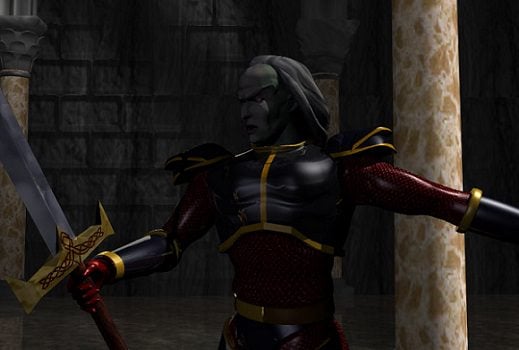



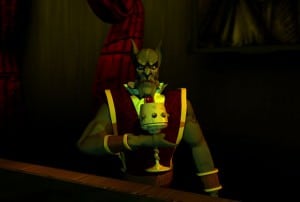
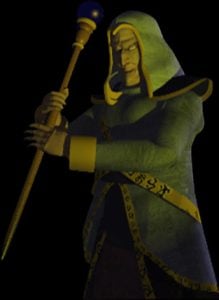

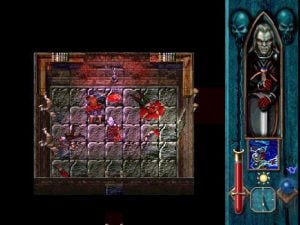


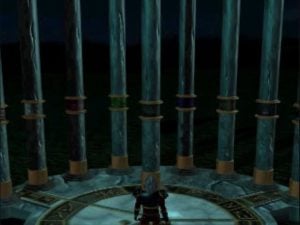
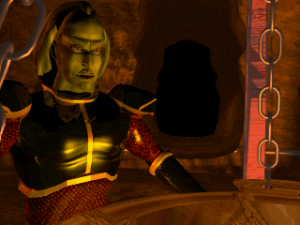
7 responses to “Retrospective – Blood Omen: Legacy of Kain”
Have a great time with…
>
As far as I know, all of the PS1 and PS2 classics on PSN are straight rereleases, no enhancements.
>
I don’t blame you. Although it’s not a terrible game in its own right, Blood Omen 2 doesn’t work in terms of the overall story at all, a lot of contradictions and poor choices.
>
Have fun with it, maybe I’ll get around to doing it myself sometime, although my current backlog would suggest otherwise…
I imagine that the one on PSN is the only remake. I suppose re-release should have been a better word, but I was not sure exactly how it is marketed (they might have enhanced graphics, idk)
I haven’t played LoK-BO since it first came out, so my memory of how it looked is sketchy.
I can’t count BO-2 as part of the series. I can’t remember all the details, but I remember that they messed up the story in many ways (contradictions and such). so I won’t be playing BO-2 again.
but I am very much looking forward to SR-1. technical issues be damned. that is one of my favorite games of all time. I haven’t played it in about 13 years.
>
One of my all-time favourites as well, the game’s atmosphere, story and characters totally captured my imagination when I first played it (much as Demon’s Souls and Dark Souls would years later), hence why I wanted to write this article. As for my favourite character, it has to be Kain himself.
>
Yep, a single-player-only adventure / RPG series renowned for its story and characters and what does the publisher do for a new entry in the series? Release a free-to-play, online-only, multiplayer action game. Yet another genius decision from Square Enix.
If you’re unaware of it, you should check out Legacy of Kain: Dead Sun. Oh, what could have been…
>
By “remake” you mean the digital rerelease on PSN, right? I played Blood Omen: Legacy of Kain again last year and it was great. I’d love to play through the entire series again, mostly to experience the whole story again, but story-wise Blood Omen 2 is an utter mess while some technical and gameplay aspects of the first Soul Reaver haven’t aged very well, so I think I’d struggle to justify the time it would take to do so.
Legacy of Kain/Soul Reaver is one of my all time favorite series.
one of the best stories in gaming, imo.
I recently bought the remake of the first one on PSN. I’m not going through it very fast. I just do little bits at a time, but I plan to go through the entire series again.
and I mean very slow. I seriously just got my Lupine form. I just went back to Demon Souls after an incredibly long time away, so who knows when I’ll actually get through the LoK/SR series again.
side-note for any ‘Breaking Bad’ fans-
Anna Gunn, the actress who plays Skyler on BB, also did the voice for Ariel in all of the LoK/SR games.
edit- well, I now see that my side-note is in the article. oh well…
I love the LoK series, played ’em all. There’s a fairly recent game called Battle for Nosgoth, but it’s multiplayer only . . . .
One of my all time favorites. So many memorable characters. Malek topping that list.
Log in to leave a Comment